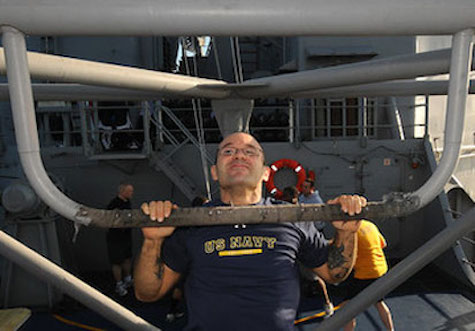The hand grip you use during upper body weightlifting will change the muscles you use for each lift. The muscles in your upper arm, chest, and upper back work to move your arm in specific directions. When you change the way you position your hands, it puts some muscles at a mechanical disadvantage, meaning they’re put in a position where they can’t optimally generate force. The good news is that there are things you can do to get the most out of your lifts for better military fitness.
Pulling exercises
When you’re resistance training, changing your hand position will change which muscles contribute most of the force to bend your elbow. While the biceps muscle in your arm is one of the most commonly known muscles, and thought of as the main elbow flexor, it’s actually not the primary muscle that bends your elbow. One of the main functions of the biceps muscle is to supinate (turn from palms down to palms up) your hand and forearm. Lifts where your hands rotate from prone to supine or stay supine throughout the full motion of the lift will best target your biceps. But doing pulling exercises in a prone or neutral (thumbs facing towards you) grip position will target your brachialis and brachioradialis muscles and limit the contribution of your biceps. There are several benefits to changing the way you target your elbow flexors. When you’re lifting or carrying objects, your hands are usually in a neutral or supine position. However, when you’re climbing, your hands are almost always prone, meaning you need arm strength to come from muscles other than your biceps.
Modifying your elbow position during pulling exercises such as rows will also change which muscles you target. Your lats and teres major are responsible for extending (raising your arm backwards), adducting (bringing your arm down towards your torso), and internally rotating your arm. When you do rowing exercises with your elbows tight to your body, you’ll mainly use these muscles. However, if you do a high row—where your elbows are up closer to shoulder height—the direction of the pull changes to horizontal abduction, which mainly uses your deltoids (the muscle that “caps” your shoulder), rhomboids, and middle trapezius in your upper back.
If there’s a time where you’re unsure about how to position your hands and elbows, try to relate it back to your most common physical tasks to make your exercises functional.
Pushing exercises
Changing your hand position during pushing exercises will change how you use your pecs and elbow extensors (triceps and anconeus muscles). Your pecs and triceps are most activated (meaning they fire the greatest number of muscle fibers) in a narrow, diamond push-up position compared to a regular position (hands under shoulders). And they have the least activation in a wide position (hands outside shoulders). Modifying your elbow position during pushing exercises also changes how you use your pecs, biceps, and deltoids—the muscle that’s responsible for abducting (raising your arm out to the side) your shoulder. You’re able to generate the most pushing force with your arms abducted about 30–60 degrees out from your sides. 45 degrees is halfway to raising your elbows to shoulder height, so 30–60 degrees is slightly less, to slightly more than halfway. This alignment puts your pushing muscles in an optimal position to generate the most force.
When you’re training to improve upper-body pushing strength, it’s important to do exercises that work the muscles in a variety of hand and elbow positions. The higher muscle activation in more narrow grips will help you train a greater percentage of muscle fibers to increase your strength. Changing up your elbow position in different exercises will affect how much each of the different muscles contributes to the movement and how much force you generate. This will affect how much weight you can lift for certain exercises and how long it takes before fatigue sets in. For example, if you do push-ups with your elbows tight to your body, you’ll mostly use your triceps and anterior deltoid to do the exercise. When you move your elbows out further, your pecs will be in a better position to do the exercise. Since you’re producing the same amount of force to do the push-up, but spread between two muscle groups, it helps you to do more before each muscle group fatigues.
Bottom line
If there’s a time where you’re unsure about how to position your hands and elbows, try to relate it back to your most common physical tasks to make your exercises functional. Unless you’re working to correct a specific deficit, like those common with shoulder injuries, there really isn’t a wrong answer to which way to position your hands. Incorporate some variety and both push and pull exercises for balance, and you’ll have a well-rounded workout routine.
